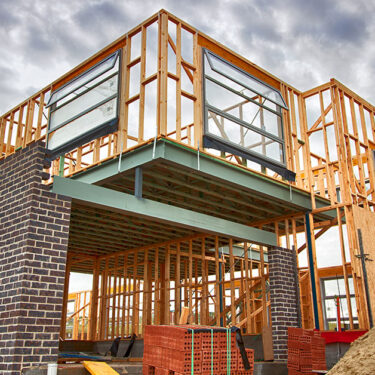A fire that destroyed much of a historic country club in Bloomfield Hills, Michigan, may have been started by construction work involving a propane torch, new video footage suggests. The Feb. 17 blaze at Oakland Hills Country Club caused an estimated $80 million in damage to the clubhouse and was a near “total loss,” according to reports. Video recovered from the scene reportedly shows construction workers rebuilding a patio and using a propane torch against a wall to install rubberized flashing; shortly thereafter, workers saw smoke coming from the wall.
Built in 1922, the Oakland Hills clubhouse is the second-largest wood structure in Michigan and housed a significant number of invaluable golf history items — many of which were salvaged.
Featured Solutions
While the fire remains under investigation, officials said the construction workers seen in the video did not call 911 and may have believed they had only a small fire, which they attempted to put out with a garden hose. If it is determined that the workers caused the fire, the liability implications could be severe, said Steven Hrab, Director, Construction, Burns & Wilcox, Toronto, Ontario. The construction company’s Commercial General Liability (CGL) Insurance would be critical in such a case.
“It is immensely serious, and I think there could be a lot of liability lawsuits from this,” Hrab said. “I do not know that the average tradesperson or general contractor would even carry enough liability insurance to cover an $80 million loss, so they could run into some problems.”
Use of heat in construction projects poses high fire hazard
While no one was injured in the Oakland Hills Country Club blaze, fires in the U.S. caused 3,500 civilian deaths and 15,200 injuries in 2020, according to the National Fire Protection Association (NFPA). Between 2013 and 2017, fires in structures under construction, in particular, caused an average of four civilian deaths and 49 civilian injuries per year, along with about $304 million in direct property damage annually, according to the NFPA.
In Winnipeg, Manitoba, an early February fire at a condominium construction site took over 12 hours to extinguish. It destroyed the entire four-story building and damaged nearby structures and vehicles, CBC News reported.

It is obviously a very catastrophic loss, not just from the financial side but also the nostalgia and tradition.
Fire is a serious risk in the construction industry, Hrab said, particularly when it comes to heat applications, such as the use of a propane torch seen in the Oakland Hills Country Club fire. In fact, some CGL Insurance carriers may even exclude these operations due to the fire risk involved or require contractors to monitor heat applications for a designated amount of time to ensure safety.
“It is basically heating up tar and melting it to create a waterproof membrane,” he explained, pointing out that many types of construction activities involve heat applications. “When there is an application of heat around a wood frame, the potential for fire — even for a plumber who works on water — is great.”
Any construction work involving heat may be more prone to losses, Pfister agreed. “It is such a high-risk exposure,” he said, and these activities must be disclosed to the company’s insurance carrier even if it is a minor component of their operations. “You can see the magnitude of a loss that can ensue because of work like that. Ensuring that it is properly addressed and understood with your insurance carrier is critical.”
Fires can also be started by contractors without the use of heat, Hrab said, referencing a recent claim in which a contractor nicked a wire while installing insulation in a $7 million home and caused a $5 million fire loss. “The losses can be quite large,” he said.
Injuries, construction defaults among other construction risks
When a construction company faces a lawsuit over a fire or other incident, its CGL Insurance can help pay for third-party bodily injury expenses, such as medical costs, and third-party property damage. This type of policy is usually carried by the individual contractors on a job site as well as the general contractor overseeing the project, Hrab said. Some construction professionals will also carry Professional Liability Insurance, while the facility undergoing renovations should be covered by Builder’s Risk Insurance or Course of Construction Insurance, he said.
CGL Insurance can also cover third-party injuries that occur on a construction site. This could include exposure to paint fumes, for example, or someone who gets hurt after accidentally entering a construction zone, Pfister said.
“Construction areas should be zoned off and have proper signage to ensure there is no third-party accidental trespassing,” he said. “Construction companies need to understand the risks of what they are doing and how it could affect a third party, and take steps to avoid the possibility of that.”
Worker injuries, meanwhile, would generally be covered by Workers’ Compensation Insurance, which is regulated on a state level and can cover medical bills, partial salary reimbursement, rehabilitation, or death benefits. In February, a 24-year-old man operating a dump truck at a construction site in Broward County, Florida, drowned after the truck fell into a canal, the Palm Beach Post reported. Another man was killed in Panama City, Florida, earlier this year after a construction site accident involving heavy machinery, WMBB reported, while a construction worker in Mississippi died in January after being buried under 20 feet of debris when a trench collapsed, according to WJTV.
“Safety measures are extremely important, not only to prevent third-party injuries but also for your workers,” Pfister said.
Construction defects that are found after a project is completed may also be covered under a company’s CGL Insurance. In February of 2020, a couple in Cochrane, Alberta, launched a $11 million class-action lawsuit against a homebuilder, alleging that water leakage and mold issues contributed to their daughter’s death, and accusing the builder of negligence and breach of contract in construction, CTV News reported.
Construction defect laws vary by state, Pfister said. “If a general contractor is building a new neighborhood, they will want to carry high limits of liability because if something is wrong with one home, something is likely to be wrong with all of them,” he said. “There are certain things that can happen that sometimes are not realized until months later.”
Transparency, risk assessment key when seeking CGL Insurance
Excess Liability Insurance is an important consideration for construction companies and can offer limits above and beyond standard CGL Insurance policies. This is especially important for companies that work on high-value properties, where the potential for a major loss may be greater. If a company is responsible for a loss that exceeds their insurance limits, “it could derail the business,” Pfister said. “It could bankrupt your company,” he said.

It is important for a company to make sure they are addressing their insurance needs and limit needs relative to the type of project they are working on.
When reviewing an application for CGL Insurance, insurance carriers will typically want to know about the type of work a construction company performs, its most recent projects and its usual clients. Transparency is key during this process, Pfister said. “Make sure you are honest about what you have going on, because just saving $1,000 on your policy upfront could end up putting you out of business on the back end,” he said.
Insurance carriers will also want to know that the construction company is hiring experienced workers, Hrab said. “With any type of risk, getting the proper workers on the site is most important. That starts with the general contractor overseeing the project,” he said. “It is important to know that this individual has done similar builds in the past and has experience with them. If something does arise, they have been in this situation before and will know how to handle the risk.”
When seeking CGL Insurance, construction companies should verify that their business activities are covered by the policy, with no exclusions that could leave them with an uninsured loss, Pfister added. “Make sure there is nothing that is specifically excluded that could be in direct conflict to your operations,” he said. “It is important for a company to make sure they are addressing their insurance needs and limit needs relative to the type of project they are working on.”
Working with an insurance broker who specializes in the construction industry is also essential, Hrab said. “The experience level and the knowledge of the insurance professionals, from the broker to the underwriters, will also help protect your interests,” he said. “If you go for a cheaper policy where the coverages are not as enhanced, it could leave the owner on the hook for a potential loss.”






